Blissful Sweetness Unleashed: Unveiling the Delightful Peruvian Suspiro a la Limeña

Peru is famous for its diverse and flavorful cuisine, and one of the most beloved desserts in the country is Suspiro a la Limeña. This creamy and sweet dessert has a rich cultural significance and a fascinating history that spans back to the colonial era. In this blog post, we’ll explore the origins of Suspiro a la Limeña, its cultural significance, and provide a step-by-step recipe for you to try at home. Suspiro a la Limeña History Suspiro a la Limeña has its origins in Lima, the capital city of Peru. It was created during the colonial era and is said to have been inspired by the French dessert, “Leche Merengada.” The dessert’s name, “Suspiro a la Limeña,” translates to “Sigh of the woman from Lima.” The dessert got its name because it was believed to be so delicious that it would cause the person eating it to let out a contented sigh. Suspiro a la Limeña Cultural Significance Suspiro a la Limeña is not only a beloved dessert but also has cultural significance in Peru. It is often served at special occasions and celebrations, such as weddings, birthdays, and holidays. The dessert is also closely associated with Lima’s culinary identity and is featured prominently in the city’s food scene. Suspiro a la Limeña Ingredients Suspiro a la Limeña Instructions Suspiro a la Limeña Cooking Time The total cooking time for Suspiro a la Limeña is around 30-40 minutes. It is important to keep an eye on the dessert while it’s cooking and to stir it constantly to prevent it from burning or curdling. In conclusion, Suspiro a la Limeña is a classic Peruvian dessert that is beloved for its rich cultural significance and delicious flavor. With this easy-to-follow recipe, you can now bring a taste of Peru into your home and impress your friends and family with your culinary skills. More Latin American Recipes More Peruvian Recipes More Dessert Recipes Follow Us on Instagram
Exploring the Cultural Significance and Deliciousness of Peruvian Rocoto Relleno
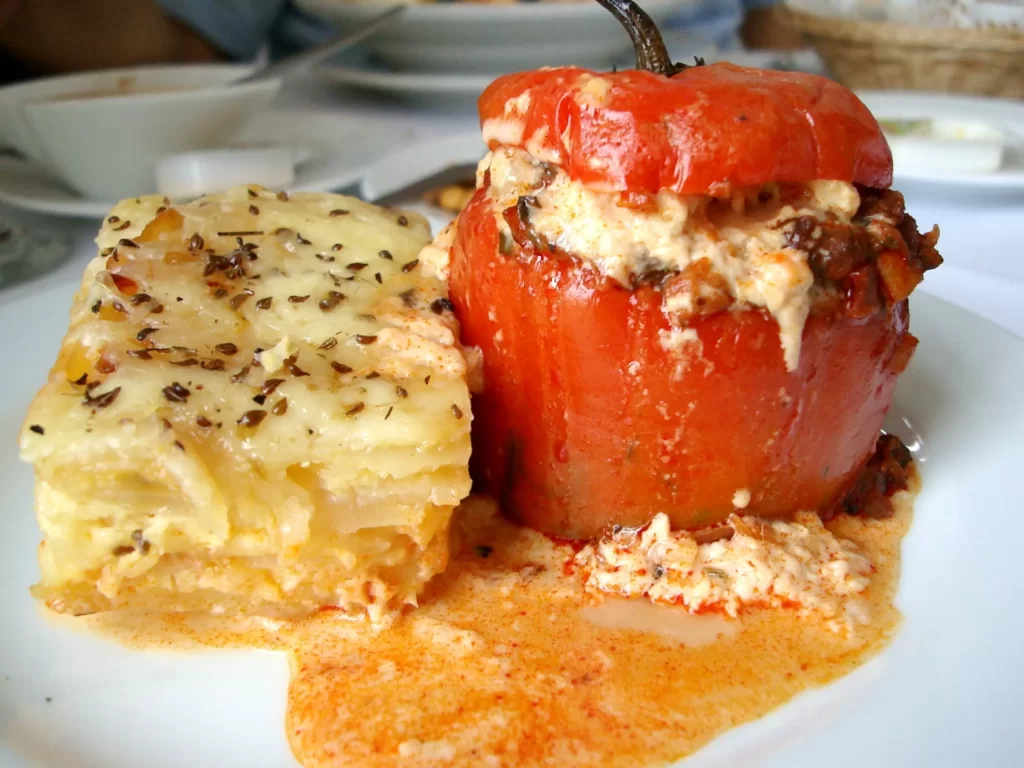
Peruvian Rocoto Relleno – A Spicy and Delicious Stuffed Pepper Recipe Peruvian cuisine is renowned for its bold and complex flavors, and the rocoto relleno is no exception. This dish is a popular Peruvian stuffed pepper that is hearty, spicy, and incredibly flavorful. In this blog post, we will guide you through the recipe for making this classic dish, as well as explore its cultural significance and history.<h2>Cultural Significance and History</h2> Rocoto relleno is a dish that is deeply rooted in Peruvian culture and history. It is said to have originated in the Arequipa region of Peru, which is located in the southern part of the country. The dish is typically served during special occasions and celebrations, such as weddings and religious festivals. The rocoto pepper, which is the main ingredient in this dish, is also significant in Peruvian culture. It is a staple ingredient in many Peruvian dishes and is believed to have originated in the Andes mountains. The rocoto pepper has a distinctive flavor and is known for its spiciness, which is a key element in the rocoto relleno. Rocoto Relleno Recipe Step-by-Step Rocoto Relleno Preparation: Rocoto Relleno Cooking Time The total cooking time for rocoto relleno is approximately 1 hour, which includes preparation time and baking time. However, the actual cooking time may vary depending on the size of the peppers and the temperature of your oven. Conclusion Rocoto relleno is a classic Peruvian dish that is full of flavor and history. Its spicy and hearty filling, combined with the distinctive flavor of the rocoto pepper, make it a unique and delicious addition to any meal. By following the recipe above, you can experience its delicious flavors. More Latin American Recipes More Peruvian Recipes Follow Us on Instagram
Discover the Rich Flavors of Peruvian Chupe de Camarones – A Step-by-Step Recipe Guide
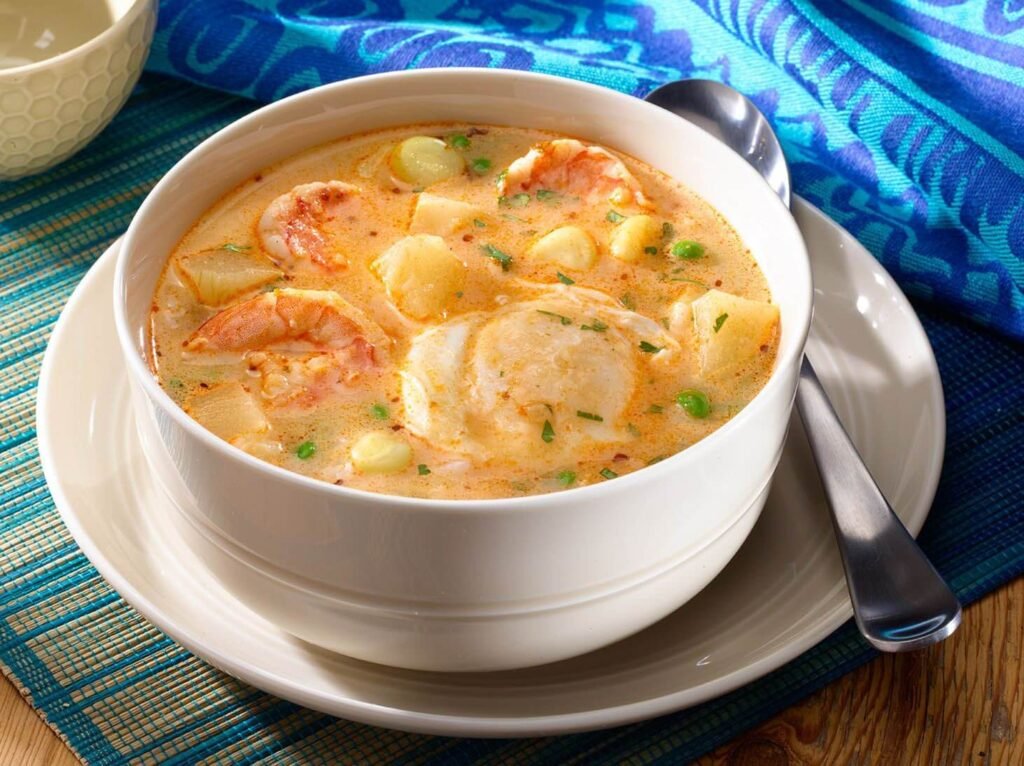
Peruvian cuisine is renowned for its bold flavors, unique ingredients, and diverse cultural influences. One dish that perfectly embodies this culinary heritage is chupe de camarones, a hearty shrimp soup that is a staple of Peruvian cuisine. In this blog post, we’ll explore the history of chupe de camarones, its cultural significance, and provide a recipe so you can try it for yourself at home. History of Chupe de Camarones: Chupe de camarones has its origins in the coastal region of Peru, where fresh seafood is abundant. The dish is believed to have been influenced by both Spanish and indigenous Peruvian cooking traditions. The word “chupe” is derived from the Quechua language, spoken by the indigenous people of the Andes, and means “soup.” The Spanish colonizers brought with them new ingredients and cooking techniques, such as the use of milk and cheese, which were incorporated into the traditional soup. Over time, chupe de camarones has become a popular dish throughout Peru, with different regions adding their own unique twists. In the city of Arequipa, for example, the soup is served with a yellow potato-based broth and queso fresco, a fresh cheese. In Lima, the capital city, chupe de camarones is often served with rice and a spicy aji amarillo pepper sauce. Chupe de Camarones Cultural Significance: Chupe de camarones is more than just a delicious dish; it also holds cultural significance in Peru. The soup is often served during special occasions, such as weddings and national holidays, and is a symbol of Peruvian identity and tradition. Additionally, chupe de camarones is a way for Peruvians to connect with their country’s rich culinary heritage. The dish’s ingredients, such as shrimp and aji amarillo pepper, are native to Peru and have been a staple of the Peruvian diet for centuries. By preparing and enjoying chupe de camarones, Peruvians are celebrating their culture and history. Chupe de Camarones Recipe: Now that you know a bit more about chupe de camarones, let’s get to the recipe! This recipe serves 6-8 people and takes approximately 1 hour to prepare. Chupe de Camarones Ingredients: Chupe de Camarones Instructions: Enjoy the rich flavors and cultural heritage of Peru with this delicious chupe de camarones recipe. Whether you’re a seasoned cook or a beginner in the kitchen, this soup is sure to impress your people. Chupe de Camarones Tip Preparing the Shrimp for Chupe de Camarones Now, let’s move on to preparing the star of the dish – the shrimp. Making the Chupe de Camarones Serving the Chupe de Camarones Enjoy your delicious Peruvian chupe de camarones! More Latin American Recipes More Peruvian Recipes Follow Us on Instagram
Discover the Rich Flavors of Peru with Causa Rellena!
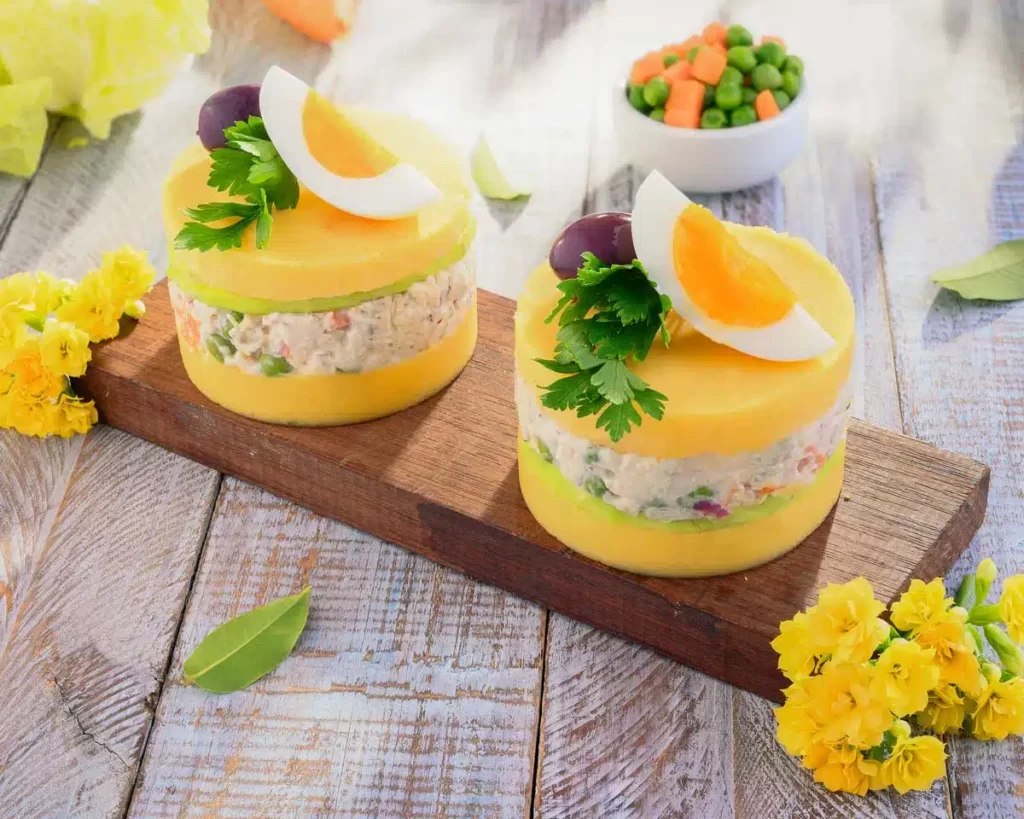
Peruvian cuisine is a vibrant mix of flavors, colors, and textures, and one dish that perfectly encapsulates this is Causa Rellena. This delicious and colorful potato-based dish is a popular appetizer in Peru and is also served as a main course. In this post, we will explore the origins of Causa Rellena, share a recipe for making it at home, and discuss its cultural significance. Causa Rellena History and Origin: The origins of Causa Rellena can be traced back to the Inca empire, where the dish was known as “papa rellena.” The Incas cultivated and ate potatoes, and they used them in a variety of dishes, including stuffed potatoes. When the Spanish arrived in Peru in the 16th century, they brought with them new ingredients and cooking techniques. The Peruvians adapted these ingredients and techniques into their cuisine, and this is how Causa Rellena was born. The dish is named after the word “causa,” which means “cause” or “reason.” The dish was originally created as a way to provide sustenance to the soldiers fighting for Peru’s independence in the early 19th century. The dish was portable, easy to make, and provided a source of carbohydrates and protein. Causa Rellena Recipe: Causa Rellena Ingredients: Causa Rellena Instructions: Causa Rellena Cooking Time: The cooking time for Causa Rellena is approximately 45 minutes, including preparation and cooling time. This recipe serves 6-8 people. Causa Rellena is a versatile dish that can be served as an appetizer or a main course. The dish is colorful and visually appealing, and its layers of flavor make it a crowd-pleaser. The key to making great Causa Rellena is using fresh and flavorful ingredients, such as aji amarillo paste, which is a type of Peruvian yellow pepper paste that is essential to the dish’s unique flavor. In conclusion, Causa Rellena is a delicious and visually stunning dish that is an important part of Peruvian cuisine. The dish has a rich history that dates back to the Inca empire and has evolved over time to become a beloved appetizer and main course in Peru. While the dish may seem complex, it is worth trying for its bold and delicious flavor. So why not give it a try and experience the flavors of Peru in your own kitchen? You may find that it becomes a favorite dish in your household and a fun way to introduce your family and friends to Peruvian cuisine. Causa Rellena its Cultural Significance: Causa Rellena is not just a tasty dish; it also holds cultural significance in Peru. The dish is often served at special events, such as weddings, birthdays, and national holidays. It is also a popular dish during Easter, where it is served as part of a traditional Easter lunch. Additionally, Causa Rellena is a symbol of Peruvian identity and a way for Peruvians to connect with their heritage. The dish’s ingredients, such as potatoes and aji amarillo, are native to Peru and have been a staple of the Peruvian diet for centuries. By preparing and enjoying Causa Rellena, Peruvians are celebrating their country’s unique and diverse culinary heritage. Moreover, Causa Rellena is also an excellent example of how Peruvian cuisine has evolved over time. The dish has incorporated new ingredients and cooking techniques from other cultures, such as mayonnaise and avocado, and has adapted them to the Peruvian palate. In this way, Causa Rellena reflects Peru’s history of cultural exchange and its ability to embrace new influences while preserving its traditions. Causa Rellena in Conclusion: Causa Rellena is a dish that embodies the vibrancy and diversity of Peruvian cuisine. Its rich history, bold flavors, and colorful appearance make it a beloved dish in Peru and a must-try for anyone interested in exploring the country’s culinary heritage. With its layers of potatoes, filling, and garnish, Causa Rellena is a dish that is sure to impress your guests and introduce them to the unique flavors of Peru. Whether you are a seasoned cook or a beginner in the kitchen, this recipe is straightforward and easy to follow. So why not give it a try and enjoy a taste of Peru in your own home? You may find that Causa Rellena becomes a new favorite in your household and a fun way to connect with Peruvian culture. More Latin American Recipes More Peruvian Recipes Follow Us on Instagram
Anticuchos: The Fascinating History and Flavorful Recipe of Peru’s Beloved Beef Heart Skewers
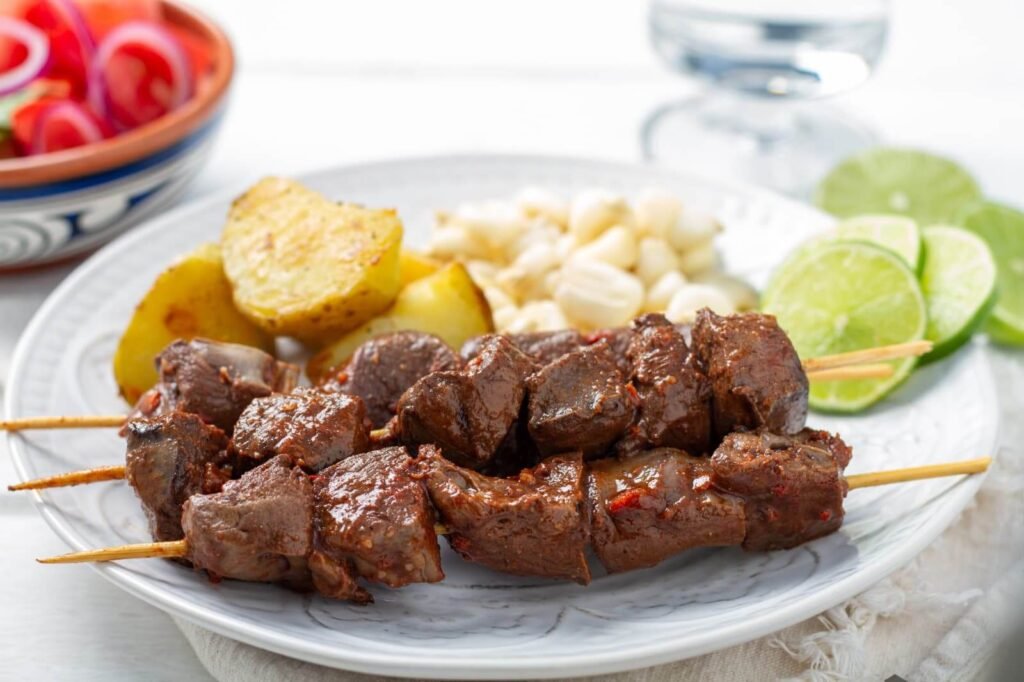
Peruvian cuisine is full of bold flavors and unique dishes, and one that stands out is Anticuchos. These skewered and grilled beef hearts are a beloved street food in Peru and have a rich history that dates back to the Inca empire. In this post, we will explore the origins of Anticuchos, share a recipe for making them at home, and discuss their cultural significance. Anticuchos History and Origin: Anticuchos have a long and fascinating history that is intertwined with the Inca empire. The Inca people were skilled farmers and herders, and they raised llamas and alpacas for their meat. They also believed that the heart was the most sacred part of the animal, as it was believed to contain the spirit and life force of the animal. The Incas would skewer the hearts and roast them over an open fire, and this tradition was passed down through the generations. When the Spanish arrived in Peru in the 16th century, they brought with them cattle and other livestock, including cows, which were not native to the region. The Peruvians adapted their tradition to use the beef hearts, and this is how Anticuchos were born. Anticuchos became popular street food in Peru in the mid-20th century and are now a staple of Peruvian cuisine. Anticuchos Recipe Anticuchos Ingredients: Anticuchos Instructions: Anticuchos Cooking Time: The cooking time for Anticuchos is approximately 10-15 minutes, including preparation and cooking time. This recipe serves 4-6 people. Anticuchos are traditionally served as a street food, but they can also be served as a main dish or as an appetizer. The key to making great Anticuchos is using fresh beef hearts and aji panca paste, which is a type of Peruvian red pepper paste that is essential to the dish’s unique flavor. The marinade also adds depth and richness to the beef. In conclusion, Anticuchos are a unique and flavorful dish that is an important part of Peruvian cuisine. The dish has a rich history that dates back to the Inca empire and is now a beloved street food in Peru. While the dish may seem unusual to some, it is worth trying for its bold and delicious flavor. So why not give it a try and experience the flavors of Peru in your own kitchen? More Latin American Recipes More Peruvian Recipes Follow Us on Instagram
Papas a la Huancaina: A Delicious and Iconic Peruvian Appetizer
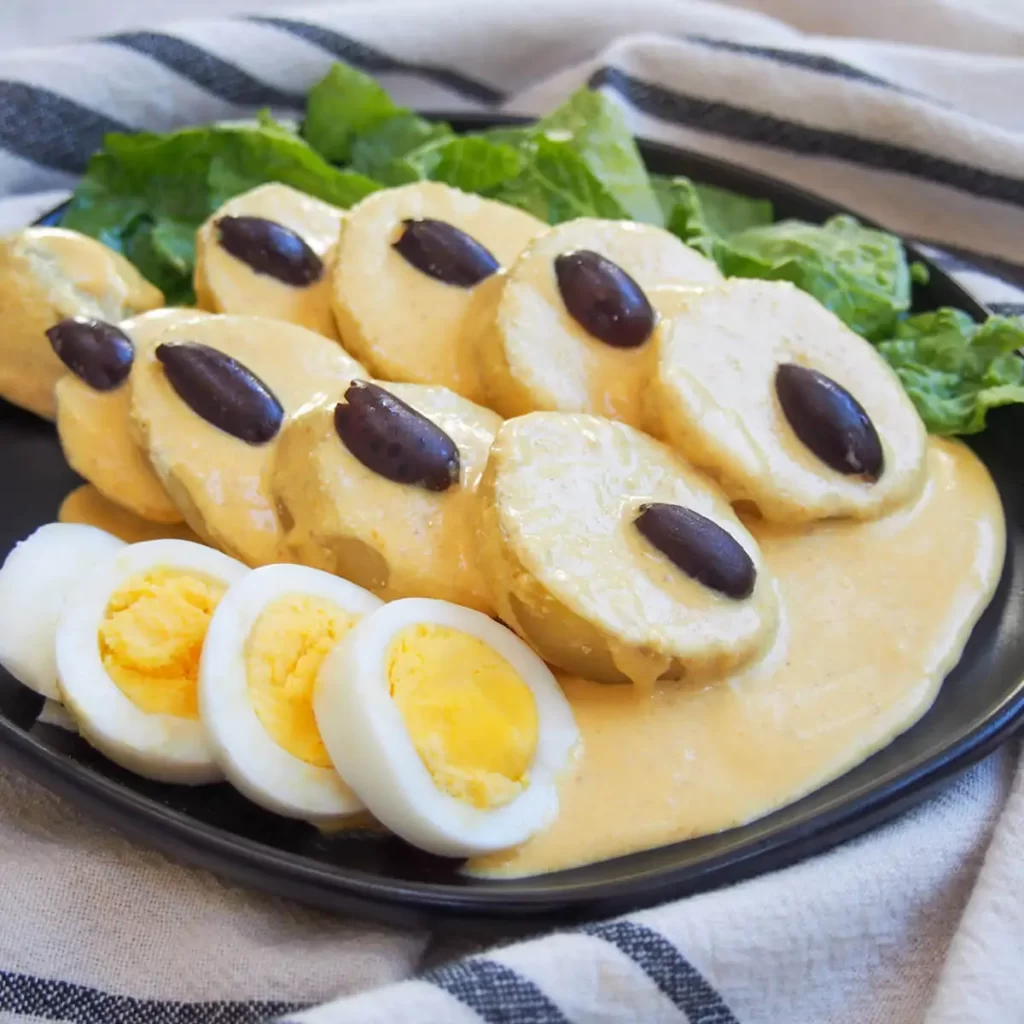
Peruvian cuisine is known for its unique and flavorful dishes, and one of the most beloved is Papas a la Huancaina. This traditional Peruvian appetizer consists of boiled potatoes smothered in a creamy, spicy cheese sauce known as Huancaina sauce. The dish is a favorite among Peruvians and is often served at special occasions and family gatherings. In this post, we will explore the origins of Papas a la Huancaina and share a recipe for making it at home. Papas a la Huancaina History and Origin: Papas a la Huancaina originated in the Andean city of Huancayo, located in central Peru. The dish is believed to have been created in the 19th century by the wives of railroad workers who were building the Central Railway of Peru. These women would gather and prepare meals for their husbands and other workers, and Papas a la Huancaina was one of the dishes that they would make. The dish quickly gained popularity and became a staple in the region. Today, Papas a la Huancaina is enjoyed throughout Peru and has become a symbol of the country’s culinary heritage. Papas a la Huancaina Recipe: Papas a la Huancaina Ingredients: Papas a la Huancaina Instructions: Papas a la Huancaina Cooking Time: The cooking time for Papas a la Huancaina is approximately 45 minutes, including preparation and cooking time. This recipe serves 4-6 people. Papas a la Huancaina is a dish that is easy to make and requires only a few basic ingredients. The key to making great Papas a la Huancaina is using fresh ingredients, especially the yellow chili peppers, which are essential to the dish’s unique flavor. The dish is traditionally served as an appetizer, but it can also be served as a main dish or as a side dish to accompany grilled meats. In conclusion, Papas a la Huancaina is a delicious and popular Peruvian appetizer that is enjoyed by people all over the world. The dish is easy to make and requires only a few basic ingredients, making it a great option for novice cooks. Whether you’re a fan of Peruvian cuisine or a newcomer to the cuisine, Papas a la Huancaina is a dish that is sure to impress. So why not give it a try and experience the flavors of Peru in your own kitchen? More Latin American Recipes More Peruvian Recipes Follow Us on Instagram
Arroz con Pollo: A Delicious and Comforting Peruvian One-Pot Meal
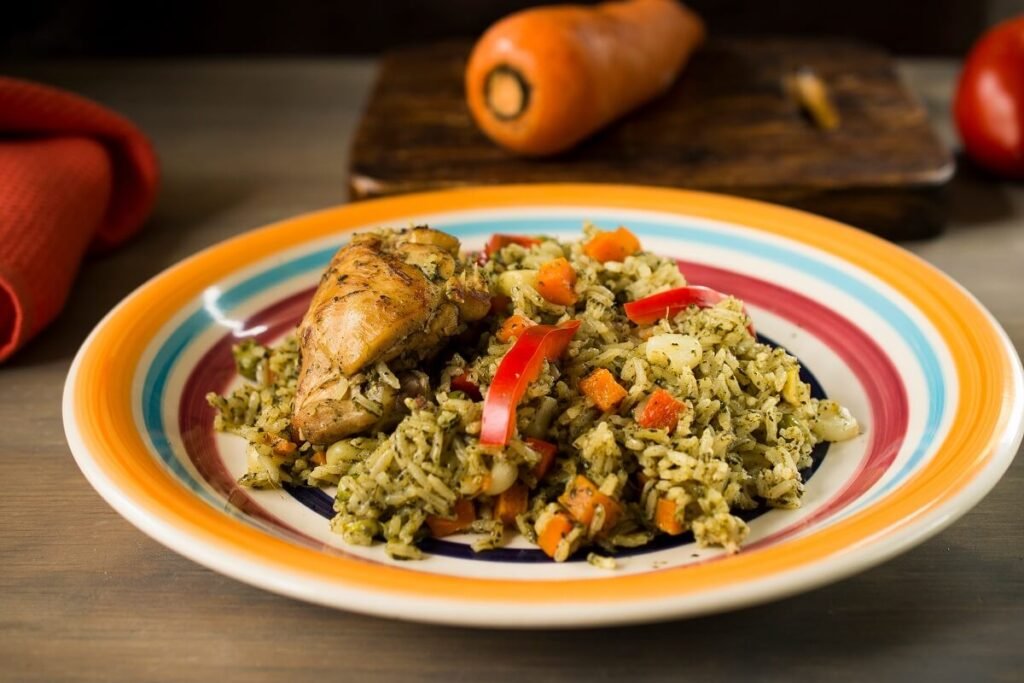
Peruvian cuisine is known for its rich flavors and diverse ingredients, and Arroz con Pollo is no exception. This classic dish is a staple in Peruvian households and is a perfect example of the country’s fusion of indigenous and Spanish culinary traditions. Arroz con Pollo is a simple and delicious one-pot meal that is easy to make at home and is sure to satisfy any craving for comfort food. Arroz con Pollo Recipe: Arroz con Pollo Ingredients: Arroz con Pollo Instructions: Arroz con Pollo Cooking Time: The cooking time for Arroz con Pollo is approximately 45 minutes, including preparation and cooking time. This recipe serves 4-6 people. Arroz con Pollo is a dish that is beloved by Peruvians and is a staple in many households. The dish is simple to make and requires only a few basic ingredients, making it a popular choice for weeknight dinners. The dish is also versatile and can be customized to your taste preferences, making it a great option for picky eaters. The key to making great Arroz con Pollo is using fresh ingredients and taking your time to develop the flavors. The dish is typically made with chicken, rice, and vegetables, but you can also add other ingredients such as olives, raisins, or saffron to give the dish a unique twist. Arroz con Pollo is a dish that embodies the flavors and traditions of Peru. The dish reflects the country’s rich culinary history and is a testament to the fusion of indigenous and Spanish culinary traditions. Whether you’re a fan of Peruvian cuisine or a newcomer to the cuisine, Arroz con Pollo is a dish that is sure to become a family favorite. In conclusion, Arroz con Pollo is a simple and delicious one-pot meal that is easy to make and is a perfect example of Peruvian cuisine. The dish is versatile and can be customized to your taste preferences, making it a great option for picky eaters. So why not give it a try and experience the flavors of Peru in your own kitchen? More Latin American Recipes More Peruvian Recipes Follow Us on Instagram
Ají de Gallina: The Iconic Creamy Peruvian Chicken Dish You Need to Try
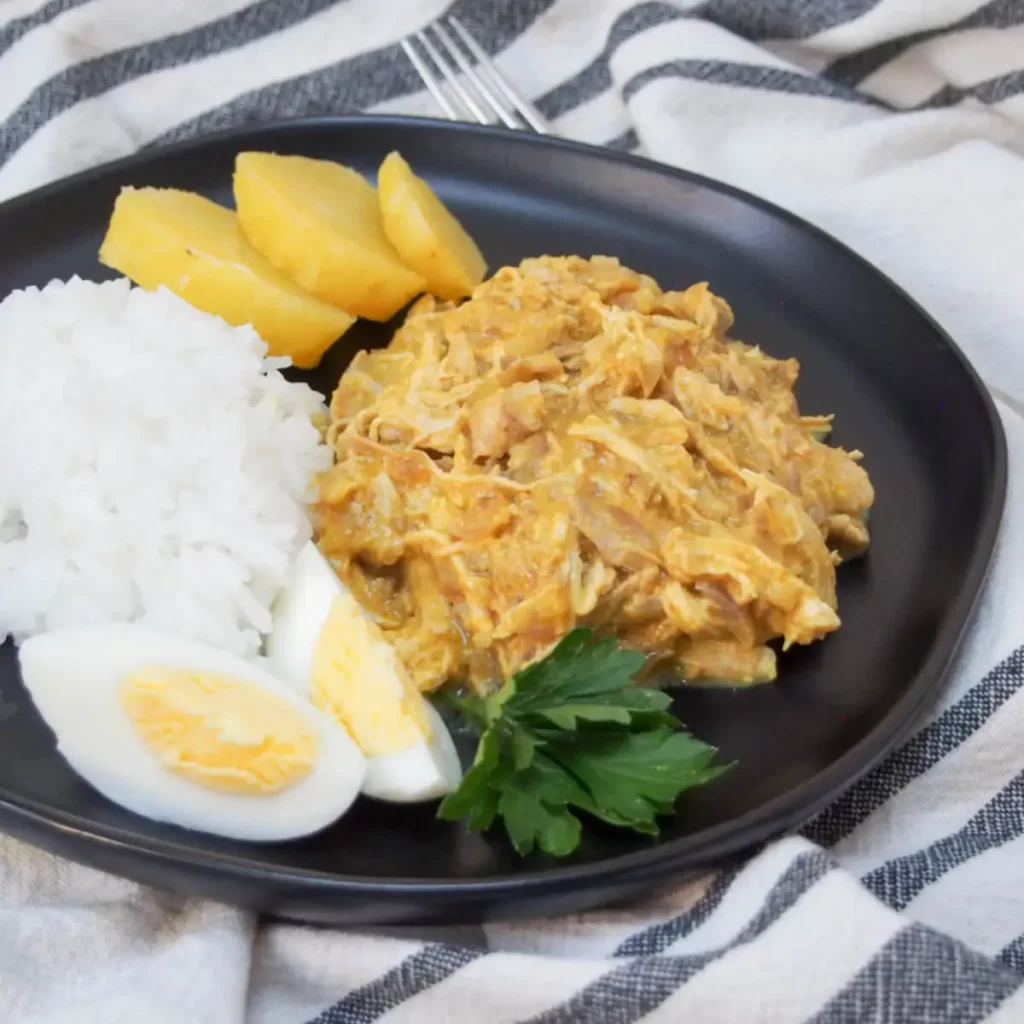
Peruvian cuisine is a unique and diverse fusion of flavors and cultures that reflects the country’s history and geography. One of the most iconic and beloved dishes of Peruvian cuisine is Aji de Gallina, a creamy chicken dish that is rich in flavor and history. If you haven’t tried this mouthwatering dish yet, you’re in for a treat. Ají de Gallina Recipe: To make Aji de Gallina, you will need the following ingredients: Ají de Gallina Cooking Time: Preparation time: 30 minutes Cooking time: 45 minutes Serving: 6 people Ají de Gallina Instructions: Aji de Gallina is a dish that has a rich and complex history. The dish is believed to have originated in Lima during the colonial period, when Spanish settlers brought their culinary traditions to Peru. The dish is now considered a national treasure and is a staple of Peruvian cuisine. One of the key ingredients in Aji de Gallina is yellow chili peppers, also known as aji amarillo. These peppers are a staple of Peruvian cuisine and have a unique flavor and heat that is different from other chili peppers. The peppers are usually roasted and then blended with other ingredients to make a flavorful paste that is used in many Peruvian dishes. The addition of walnuts and bread to the dish adds a unique texture and flavor. The walnuts add a nutty and slightly sweet flavor, while the bread helps to thicken the sauce and make it creamy. The use of evaporated milk and parmesan cheese in Aji de Gallina is another unique aspect of the dish. The combination of these two ingredients creates a rich and creamy sauce that complements the chicken and chili peppers perfectly. In addition to being delicious, Aji de Gallina is also a healthy dish. Chicken provides protein, while the yellow chili peppers and walnuts add vitamins and minerals. The dish is also low in fat and can be made gluten-free by using gluten-free bread. In Peru, Aji de Gallina is a popular dish that can be found in many restaurants and homes. The dish is often served during special occasions and celebrations, such as Independence Day and Christmas. Overall, Aji de Gallina is a must-try dish for anyone looking to experience the flavors of Peru. The combination of chicken, yellow chili peppers, walnuts, and cheese creates a complex and flavorful dish that is sure to impress. The dish is also easy to make at home and can be customized to your taste preferences. When making Aji de Gallina, it’s important to use fresh ingredients and take your time to develop the flavors. The dish requires a bit of preparation and cooking time, but the end result is well worth the effort. You can also experiment with the ingredients and adjust the spice level to your liking. Aji de Gallina is a dish that embodies the rich history and culture of Peru. The dish reflects the country’s diverse culinary traditions and the influence of Spanish, African, and indigenous cultures. Whether you’re a fan of Peruvian cuisine or a newcomer to the cuisine, Aji de Gallina is a dish that you won’t want to miss. In conclusion, Aji de Gallina is a creamy and delicious Peruvian chicken dish that is rich in flavor and history. The dish combines chicken, yellow chili peppers, walnuts, and cheese to create a unique and flavorful dish that is sure to become a family favorite. So why not give it a try and experience the flavors of Peru in your own kitchen? More Latin American Recipes More Peruvian Recipes Follow Us on Instagram
Peruvian Lomo Saltado: A Classic Stir-Fry Dish You Need to Try

Peruvian cuisine is a melting pot of flavors and cultures that reflects the country’s history and diversity. One of the most beloved and iconic dishes of Peruvian cuisine is Lomo Saltado, a stir-fry dish that blends the flavors of China and Peru. This mouthwatering dish is a must-try for anyone looking to experience the richness of Peruvian cuisine. Lomo Saltado Recipe: To make Lomo Saltado, you will need the following ingredients: Lomo Saltado Cooking Time: Preparation time: 20 minutes Cooking time: 20 minutes Serving: 4 people Lomo Saltado Instructions: Lomo Saltado is a simple yet flavorful dish that is perfect for a quick weeknight dinner or a weekend get-together. The dish is easy to make and can be adapted to your taste by adding or subtracting ingredients. The beef strips are the star of the dish, and the key to a successful Lomo Saltado is to use high-quality beef that is cut into thin strips. The beef is first stir-fried until browned on all sides, which adds flavor and texture to the dish. The sauce is what brings all the flavors together in Lomo Saltado. The combination of soy sauce, red wine vinegar, beef broth, and cumin powder creates a savory and slightly tangy sauce that complements the beef and vegetables perfectly. Lomo Saltado Tips: One of the unique aspects of Lomo Saltado is the addition of French fries, which might seem odd at first but adds a satisfying crunch to the dish. The fries are traditionally served on top of the stir-fry, but you can also serve them on the side. In addition to the French fries, Lomo Saltado is typically served with white rice. The rice helps to balance out the flavors of the dish and provides a neutral base for the stir-fry. While the recipe for Lomo Saltado is relatively simple, there are a few tips and tricks to keep in mind to ensure that your dish turns out perfectly. First, make sure to use high-quality beef that is cut into thin strips. This will help to ensure that the beef cooks evenly and is tender and juicy. Second, be sure to use a hot pan and stir-fry the beef quickly. This will help to seal in the juices and prevent the beef from becoming tough. Third, don’t be afraid to experiment with the ingredients. While the basic recipe calls for beef, onion, tomatoes, and chili pepper, you can add other vegetables such as bell peppers or green onions for a different flavor profile. Finally, make sure to have all your ingredients prepped and ready to go before you start cooking. Stir-frying is a fast cooking method, and you won’t have time to chop vegetables or measure out ingredients once you start cooking. In addition to being delicious, Lomo Saltado is also a healthy dish. The beef provides protein, while the vegetables add vitamins and minerals. The dish is also low in fat and can be made gluten-free by using tamari sauce instead of soy sauce. In Peru, Lomo Saltado is a popular street food dish and can be found in many restaurants and cafes. The dish is also easy to make at home and is a great way to experience the flavors of Peruvian cuisine. Overall, Lomo Saltado is a delicious and easy-to-make dish that is perfect for anyone looking to try something new. The combination of beef, vegetables, and sauce creates a mouthwatering stir-fry that is sure to become a family favorite. So why not give it a try and experience the flavors of Peru in your own kitchen? More Latin American Recipes More Peruvian Recipes Follow Us on Instagram
Peruvian Ceviche: A Refreshing and Flavorful Dish
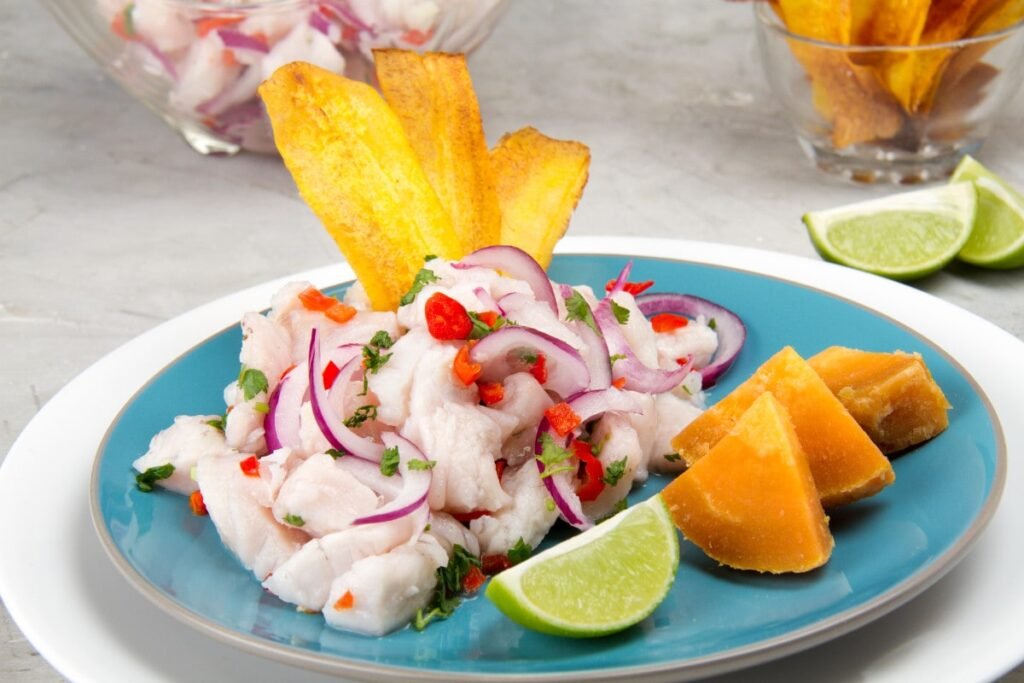
Peruvian cuisine is known for its fusion of indigenous, Spanish, African, and Asian influences, and one dish that perfectly embodies this fusion is ceviche. This dish is a staple in Peruvian cuisine and is enjoyed by locals and visitors alike. In this blog post, we will delve into the history, recipe, and cooking time for Peruvian ceviche. The Origins of Ceviche Ceviche has been a part of Peruvian cuisine for centuries and is believed to have originated in the coastal regions of Peru. The indigenous people of Peru, the Incas, were the first to prepare ceviche using fresh fish and other seafood, along with indigenous spices and seasonings. When the Spanish arrived in Peru, they brought with them new ingredients and cooking techniques, which were incorporated into the ceviche recipe. As a result, Peruvian ceviche has evolved over time to become the flavorful and diverse dish that it is today. The Recipe for Peruvian Ceviche Peruvian Ceviche Recipe Ingredients Peruvian Ceviche Recipe Instructions & Preparation Peruvian Ceviche Serving Suggestions Peruvian Ceviche Cooking Time The cooking time for Peruvian ceviche is relatively short, as the lime juice is used to “cook” the fish. The total time from start to finish is approximately 1 hour and 30 minutes, which includes 30 minutes to 1 hour of marination time and approximately 15 minutes for preparation. In conclusion, Peruvian ceviche is a refreshing and flavorful dish that is sure to delight the taste buds. With its diverse blend of indigenous, Spanish, African, and Asian influences, ceviche is a perfect representation of Peruvian cuisine. Whether you are a fan of seafood or just looking for a new and exciting dish to try, Peruvian ceviche is a must-try. More Latin American Recipes More Peruvian Recipes Follow Us on Instagram
